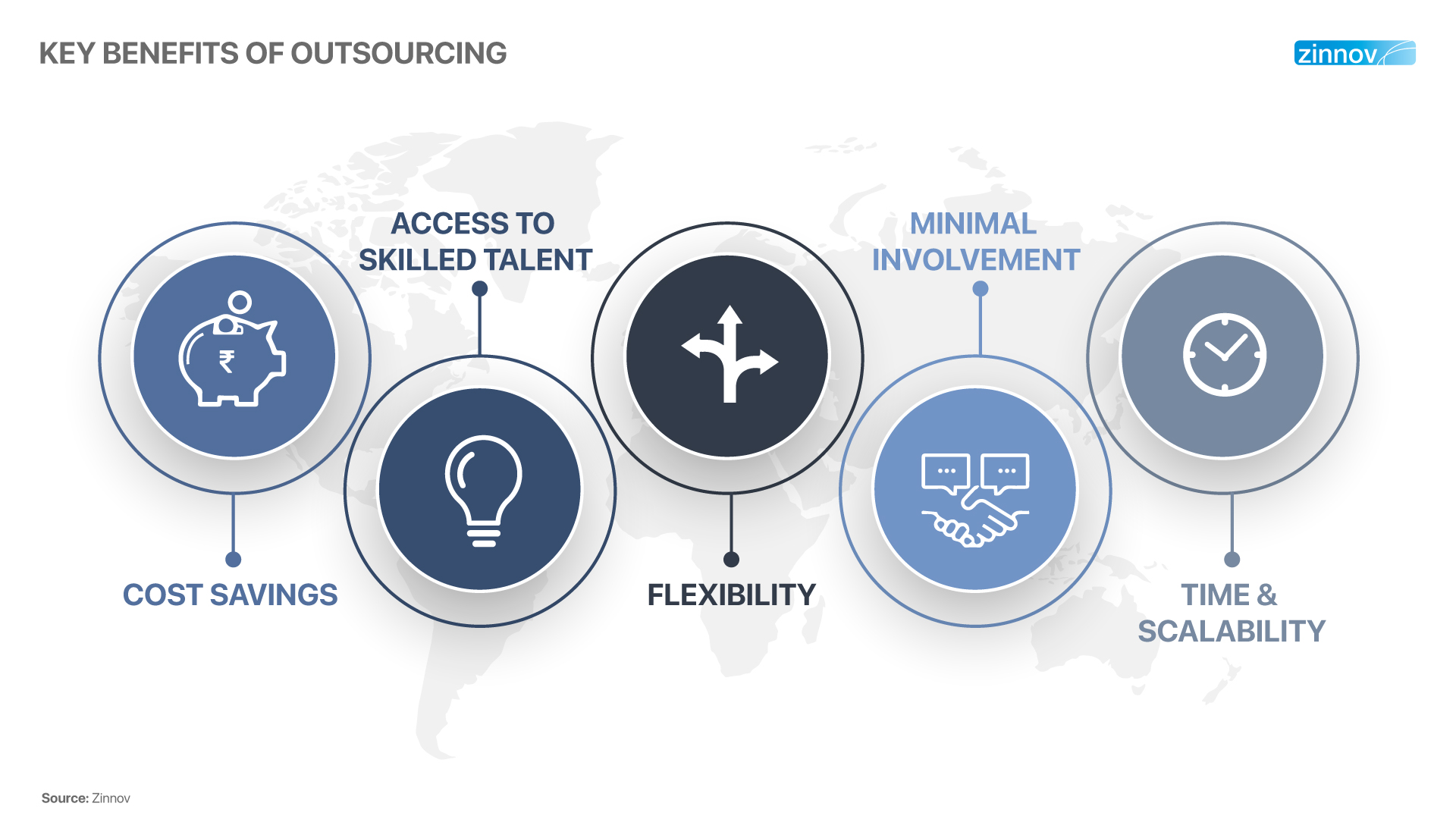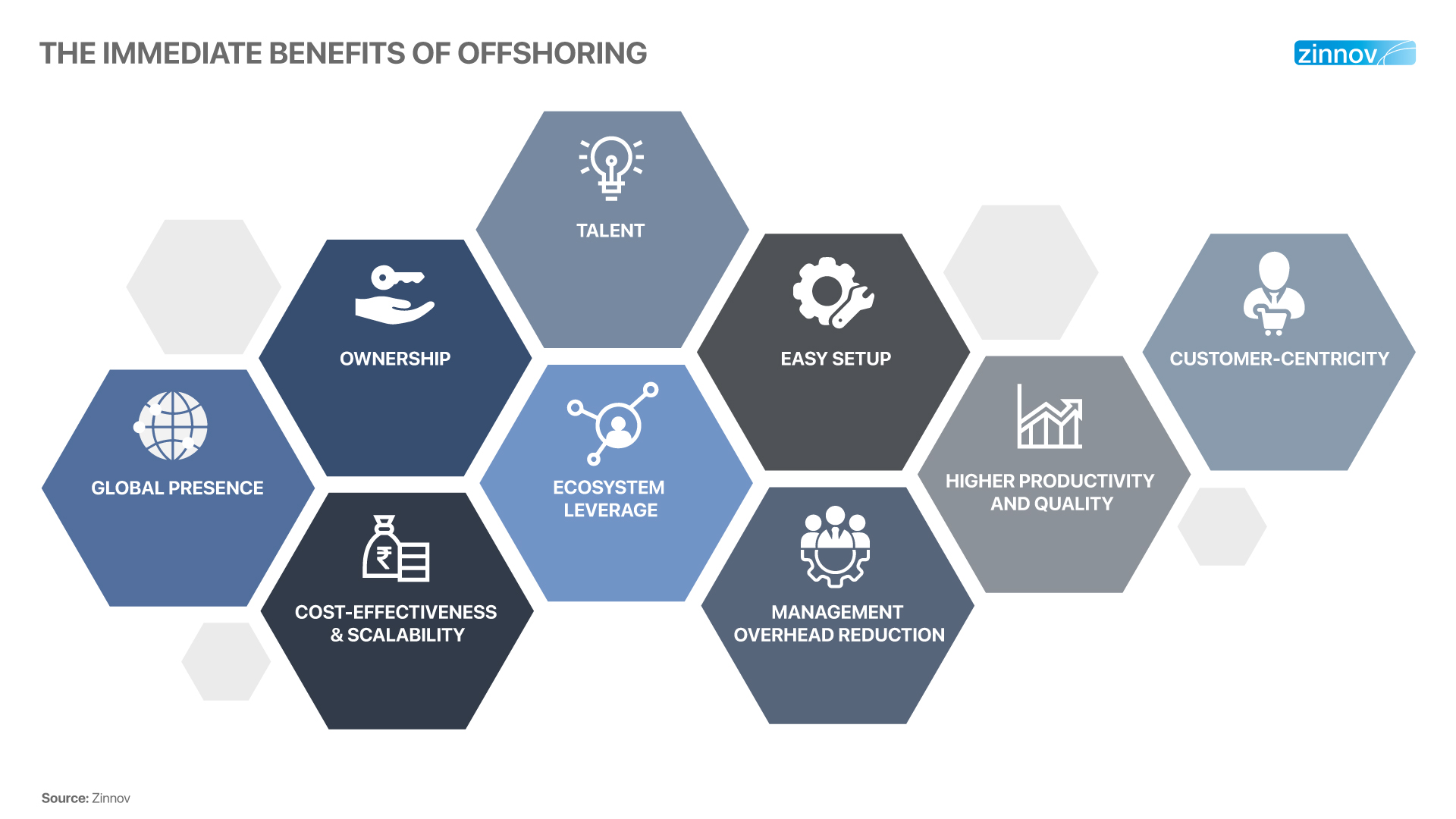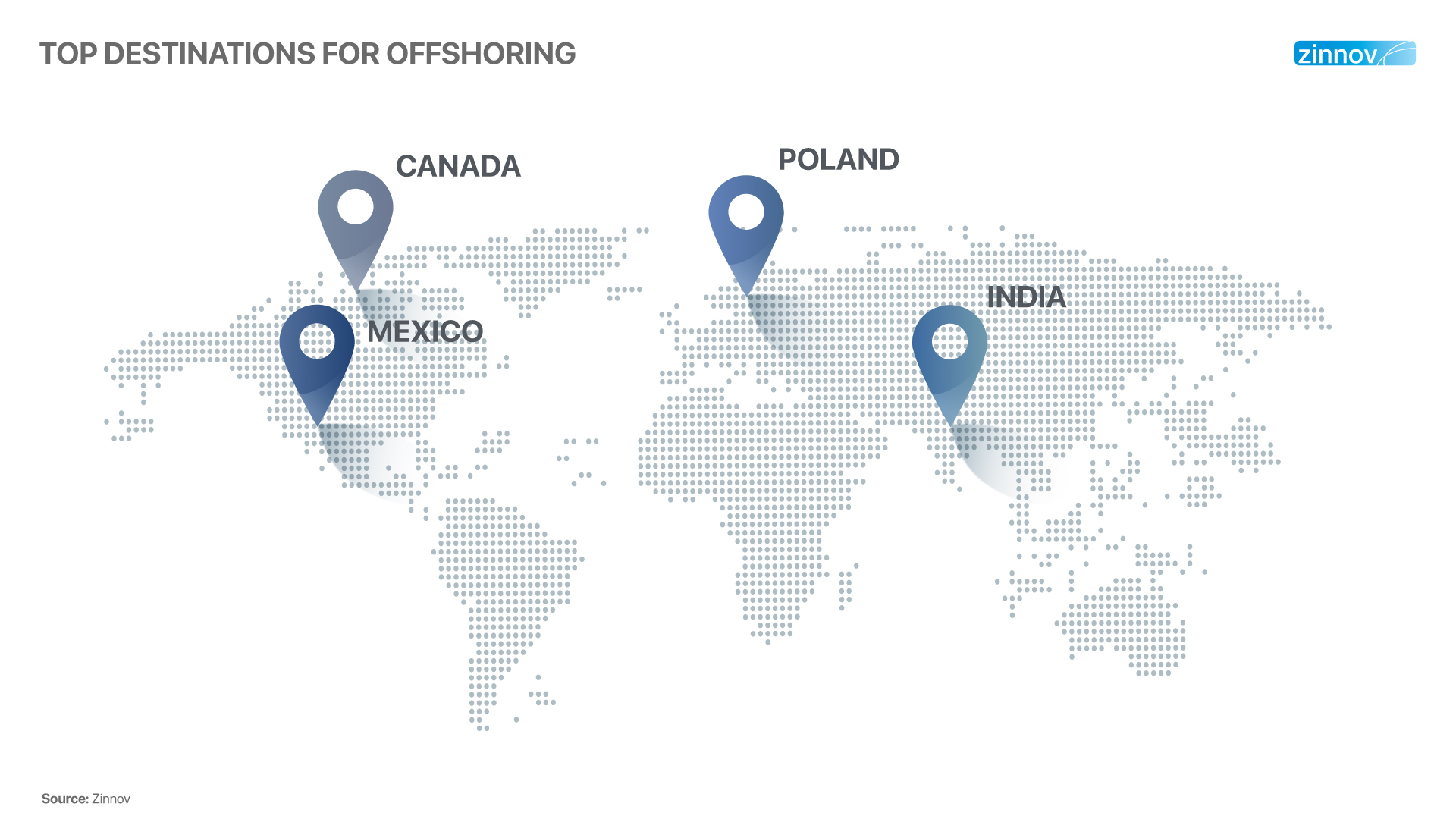|
|
COVID-19 has bolstered the demand for IT and software development talent to develop future-proof business processes and offerings. To facilitate this growing demand, offshoring and outsourcing have become major business buzzwords. However, the lines between the two might often get blurred with people colloquially thinking it to be a means to ‘get work done by a third party.’ While both include an aspect of remote working and external support, they represent two utterly contrasting business models. In this article, we will be comparing the basics of offshoring and outsourcing, finding their strengths, weaknesses, and discussing global destinations that provide exponential value.
The era of outsourcing started with the industrial revolution which started in the early 90s. It is the umbrella term used while contracting third parties to perform certain tasks as per the requirement or brief. In this model, tasks or projects undertaken are usually on a retainer or contract basis. The outsourced staff can be contractors or individual contributors who utilize their niche skills to deliver the outcome as requested. Usually, a dedicated POC (point of contact) is involved in this process who becomes the intermediary between the organization and the talent. This model has dramatically helped organizations focus on core business offerings and outsource support functions. At present, outsourcing is an extremely popular means to get tasks done, by including a definite roadmap and timeline in place.
The emergence of offshoring happened with organizations desiring to have a sense of ownership. In this model, the headquarters outsource certain components of the business to a different country. A dedicated remote team is hired for the organization, where the offshore employees can report from anywhere across the world. This team is an extension of the immediate local staff and is usually managed by CXOs sitting out of the headquarters or global centers of excellence (GCOEs also known as global capability centers or GCCs). Usually, offshore teams retain special expertise in software engineering and IT to develop new proof of concepts, expedite innovation, and transform existing workflows end-to-end. Offshoring essentially falls under the bracket of outsourcing strategies and is often interchangeably used with other outsourcing models such as nearshoring (outsourcing to nearby countries).
While both processes are time-tested and have proven to be an elixir to business growth, it’s important to know the benefits and drawbacks of both to help with informed decision-making.
Before coming to the immediate benefits of outsourcing, it’s best to understand the finer details of its roots to get a 360-degree understanding of such a model.
The industrial revolution rapidly rejigged how businesses operated. New machinery, breakthrough technologies, a new drive to think out of the box and stand apart in the marketplace became the ultimate north star. However, a demand-skill gap surfaced with the growing digital developments happening in the ecosystem and CXOs increasing their drive to emerge stronger, beat competition, increase profits, and scale operations. Though organizations were hunting for quality talent, they were also doing the math in terms of the ROI.
After numerous experiments, they started realizing the need for specialized talent outside of the organization, who would help with escalating tasks. So, internal teams took care of daily drills happening within the organization and certain functions such as creating the baseline of a new product offering, SEO optimizing the company website, etc. was handled by third party vendors on project basis. This mindset shift especially helped companies that lacked self-sufficiency or internal bandwidth, to outsource third-party vendors and enjoy the desired business outcomes. In fact, in the post-pandemic era, this model is highly sought after with the talent wars becoming intense and finance becoming the epicenter of business decisions.

Outsourcing helps reduce expenditure with pre-defined expectations set in terms of compensation, work description, and timelines mentioned. The outsourced contributor is either paid on an hourly basis or for the days needed to finish the project. Also, multiple internal processes are eliminated like the cost of including an admin and setting infrastructure.
COVID-19 has increased the need for niche skilled talent. Outsourcing helps with sourcing such talent as per the requirement and get the job done hassle-free.
Outsourcing helps with the strategic utilization of resources. One needs to show the money, only when there is a definitive task that needs special support. So, both parties can set their terms and work accordingly as per mutual consensus.
Most outsourced tasks are independent of in-house core processes. Hence, here the involvement is minimal, task to task basis, where the brief is already outlined. Only in case of confusion, the POC might need to intervene, or else outsourced staff does not need much of support.
Outsourcing is highly scalable in terms of ad-hoc or hourly tasks. It is especially beneficial during peak times of the year, when the work pressure is high, tasks are time-bound, among other things. For instance, creating project dossiers, drafting mailers, coding new algorithms, etc.
While these are the critical advantages of outsourcing, the quality of work might vary based on the outsourced staff’s approach. Either the same person would be working on the project or there might even be a rotation with other available contributors on a given day. And since the staff is not dedicatedly working for the organization, the core values of each individual will differ. The staff might also be working on multiple deliverables from different clients at the same time. This might hinder efficiency, impact deployment timelines, and the results not up to the mark.
All in all, outsourcing is a hit-and-miss approach where it can often serve the best results or leave a salty after taste in terms of not nailing the task assigned.
Humans are evolutionary species. They create, explore, and keep discovering best practices that fit their needs best.
The concept of offshoring came up with people seeking transparency and more involvement in their people, processes, and production pipelines. This model helped build a scalable talent pool, in a different geographic location, under the same leadership. Thus, organizations not only had the scope to create offshore centers (GCOEs or GCCs) across geographies, but also get access to the region’s local talent, which helped bolster innovation. In fact, a recent Zinnov survey reveals that GCC/GCOE growth has accelerated dramatically due to better access to talent, ease of setup, co-innovation benefits with other technology players, and increased cost savings. We will deep dive into the key advantages of offshoring and understand why most major players are preferring this business model over outsourcing.

Offshoring helps companies expand across geographies and leverage the fruits of the region in terms of talent, tech ecosystem, cost optimization, and ease of doing business.
Unlike the outsourcing model, leaders get complete control over the daily developments happening within the offshore teams. The CXOs of GCOEs/GCCs handle the recruitment process, training initiatives, helps teams imbibe the company culture, and more. Furthermore, daily, or weekly sync-ups happen with the headquarters to ensure the KPIs are put in place and goals aligned.
Cost arbitrage is one of the most primal factors that drive organizations toward the offshoring model. Quite a few global locations like India, Mexico, Canada, Poland, etc. are affordable and provides a high ROI for the headquarters. This cost difference is primarily due to the disparity in living expenses compared to the West. For example, as per our global hotspots analysis, a Mexican software development engineer’s (SDE) average salary expectation, usually comes to USD 38,500, compared to a U.S. SDE which comes to an estimated USD 72,162. This visible difference in compensation expectations helps build large scalable remote teams, without burning a hole in the pocket. These teams can also be leveraged to work closely with offshore clients and if needed visit the site and bring in the aspect of face value and physical collaboration. In fact, GCCS/GCOEs can provide 35% more cost savings than working with outsourced service providers.
Developing offshore centers helps access untapped talent pools with ease. It helps reduce the pressure from finding skilled talent in developed countries like the US, where the competition is super high. Thus, it’s best to not put all eggs in one basket and build global centers in different geographies, that have English-speaking capabilities and the necessary skills to get the job done.
By ecosystem we mean the presence of global companies, start-ups, education, and academia relationships, whether the laws are business-friendly in terms of income tax, employee laws, the common languages spoken, and more. So, the immediate fruits that leaders can leverage are forming partnerships with the start-ups in the region, expediting mergers & acquisitions (M&A), enjoying acquihiring, collaborating with other local IT & technology partners, and bolstering co-innovation.
The process of setting up a global center has become easy and straightforward. Leaders primarily need to be cognizant of the real estate cost and income tax regulations in their desired destination. Alternatively, they can also go for plug-and-play options, with multiple technology parks and co-working spaces like We Work, usually available in most countries. However, those who are relatively new in their expansion gameplan or those who would like strategic advisory assistance, may connect with outsourcing consultants like Zinnov, who can help them make informed decisions by providing details on the latest developments happening in the industry, introduce modern best practices, discuss existing customer use cases and approach, find constructive loopholes in the system, and more. This helps organizations enjoy a smooth expansion journey and the chances of failures become minimal.
Due to closer alignment with the business context, GCC/GCOE resources are better managed with lower overhead as compared to those with outsourced staff or service providers.
In outsourcing, most of the service providers push to staff more people on a project. In the offshoring model, the focus is on improved productivity to get more out of the current remote team. Upskilling or re-skilling initiatives are also introduced to get the best performance out of the team and enhance delivery results.
Offshore teams massively help increase the net promoter score of an organization. They dedicatedly collaborate with customers and align goals accordingly.
While these are the critical benefits of offshoring, collaborating with teams in a different time zone can be a bit of a challenge. It can lead to a delay in delivery timelines, reduced possibility of real-time collaboration, and the time-to-market may be slower, with the visible time difference. However, this drawback can be overcome if there is an involvement of experienced offshore partners who would ensure the delivery of optimal results.
Additionally, an aspect of rendering compensation when the work is less does come in. But the fact that the workforce is aligned with the company culture and leap of faith circumstances are minimal, unlike the outsourcing model, makes it a much sought-after model in recent times. Cases in point are Lowe’s 3000+ member team in India serving 20 Mn+ customers in the US. WalmartLabs reducing outsourcing requirements from 70% to 30%, and building an offshore team dedicated to build and innovate at scale. Intuit India’s team focusing on disruptive and meaningful innovation for 100 Mn customers across the world.
So, what are the top GCOE/GCC hubs that leaders can narrow down? What will provide them the best value? Let’ take a deeper look at the top global hotspots that is best suited for the offshoring model.
COVID-19 has indeed played the role of a Chief Transformation Officer in terms of the mindset shift especially. More leaders realized the need to future-proof businesses against future blows to the ecosystem. Even though the offshoring paradigm was a common phenomenon in the pre-pandemic era, but in the post-pandemic world, the demand for global expansion skyrocketed. Organizations wanted to stop keeping all eggs in one basket and broaden their reach across the globe. They started exploring global destinations that have a workforce skilled in technology, mature infrastructure, a good score on the ease of doing business index, and cost-efficient.

The country has a large demographic dividend, 1300+ GCOEs, 50+ Unicorns, a substantial repository of close to 1.5 Mn STEM (Science, Technology, Engineering, Maths) talent graduating every year, English speaking proficiency, experienced attrited talent available all time of the year, and multiple start-ups who can be leveraged to co-innovate. Also, there are good industry tie-ups with tech institutes where the research focus is around AI, ML, Low Code/No Code, among other things. Leaders who go for this destination can expect significant cost-savings, drive innovation, and enjoy long-term success.
Canada is a hub-spot for businesses to set up their GCOEs/GCCs. In the past five years, there has been a 22% growth in tech talent, with the average talent pool adding to 4.4 Mn (fresh + experienced) with a voluntary attrition rate of ~16%. The country provides 70% cost arbitrage in comparison to the US. If organizations are on the lookout for plug-and-play options, there are multiple technology parks providing substantial infrastructure. The most common languages spoken are English and French. The laws are highly employer favoring in terms of termination, notice period, and severance pay. The country also has 300+ start-ups, is in proximity to the US, allowing real-time collaboration, has a good education system, and can prove to be lighter on the pockets.
Poland has a technology talent pool of 170K+ — the largest talent pool in terms of installed and expatriate talent (talent coming in for jobs and higher education), amongst Eastern European countries. There are 600+ COEs focused on advanced technology solutions that provide software development and IT support services to companies across the globe. It has 400+ technology start-ups with Warsaw, Krakow, Wroclaw, Gdansk, and Poznan being the most developed hubs. These cities have a high focus on Big Data, IOT, FinTech, and EdTech, among other technologies. In terms of the ease of doing business, the top 3 languages spoken are Polish, German, and English, also there is a high focus on GDPR compliance, and EU citizens do not require work permits to be hired locally. However, prospects from non-EU countries would need an official employment offer from a Polish company.
Mexico has evolved as Latin America’s Center of Excellence Hub. It has a high concentration of full-stack developers, UX/UI designers, system admins, etc. The average talent pool accounts for 213k+ individuals yearly, thus keeping the potential to build scalable full software engineering teams. The talent is affordable and has similar potential to US SDE talents. In fact, Guadalajara, Monterrey, and Mexico City collectively employ 35% of the SDE talent pool in Mexico. In terms of education, Mexico has 63 universities out of the top 400 universities in the LATAM region. Most of these universities have a definitive technology bent, which is demonstrated in their research centers, focusing on Industrial Automation, AI & Robotics, Telecommunication, and more. It has 300+ technology start-ups with the VC spending reaching USD 1.2 Bn, as of 2020. Some pockets of the country like Mexico City, Guadalajara, Monterrey, Tijuana, are business-friendly and in general have employee favoring laws. It is also a good nearshore hub, due to its geographic proximity to the US.
While these are a few of the top-most destinations where we believe organizations can derive immense value, our Global Hotspots report provides a detailed analysis of 9 other potential hubs which leaders can alternatively tap into.
Both the offshoring and outsourcing models have its pros and cons. The right fitment will depend on the organizational context and work. Organizations can utilize the outsourcing model for short-term or quick projects, that do not require much integration with in-house processes. However, if the company is looking to scale operations by expanding in other geographic locations and build a niche skilled team — while still retaining complete ownership of the process, then offshoring is the way to go. In fact, we at Zinnov offer global strategic outsourcing and offshoring advisory attuned to facility build-out, talent management, acquihiring, digitalization, among other things.